CALIFORNIA—The recent avian influenza epidemic has caused a price increase in eggs across the nation.
According to the U.S. Department of Agriculture (USDA), there are two types of avian influenza classified as H5N1; one strain is highly pathogenic and capable of producing rapid widespread disease, and the other is a lower risk. The influenza virus is highly susceptible to mutation, and new strains are able to form within avian hosts.
The high pathogenic avian influenza (HPAI) is fatal to chickens and turkeys. According the USDA, the virus originated in Asia and spread rapidly along migratory pathways in 2014, including the Pacific flyway. On January 16, the USDA’s National Veterinary Services Labs confirmed an unidentified strain of the virus to be found in a wild duck species in Washington.
Prior to 2015, the virus had three major outbreaks recorded in United States history—1924, 1983, and 2004. Since December 2014, there have been several documented incidents along the Pacific, Central, and Mississippi Flyways. There are currently three deadly flu strains that have affected over 43 million birds in 15 states across the country, which have caused substantial damages for farmers.
It is estimated that nearly 10 percent of the country’s egg-laying chickens have been affected by the virus, with domestic birds being primarily affected in the Midwest farms. When farmers disinfect their farms and dispose of infected birds, it can take up to six months before USDA Animal and Plant Health Inspection Service grants approval for re-population.
This outbreak and inspection process has resulted in a significant increase in the price of eggs, due to the decrease in production. The standard rate of a dozen eggs is currently $2.62; more than double the price of $1.19 just a few months ago. Liquid egg carton prices have increased to be three times the price of what they were in April.
The wholesale cost of a dozen eggs has been raised from $1.77 to just over $3.00 in California. It is expected that prices will increase due to a national decrease in production, and California’s new law regulating the import and production of eggs. According to a law passed on January 1, all California eggs are required to be laid by chickens that are cage-free, or can fully extend their wings and move freely in their cages. The national price increase has allowed California’s egg-pricing to be on par with those that are imported from the Midwest.






